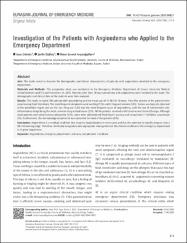| dc.contributor.author | Ertekin, Ayşe | |
| dc.contributor.author | Özdinç, Şerife | |
| dc.contributor.author | Avşaroğulları, Ömer Levent | |
| dc.date.accessioned | 2021-05-05T22:14:05Z | |
| dc.date.available | 2021-05-05T22:14:05Z | |
| dc.date.issued | 2020 | |
| dc.identifier.issn | 2149-5807 | |
| dc.identifier.issn | 2149-6048 | |
| dc.identifier.uri | https://doi.org/10.4274/eajem.galenos.2020.00821 | |
| dc.identifier.uri | https://hdl.handle.net/20.500.12933/270 | |
| dc.description | WOS:000598273800006 | en_US |
| dc.description.abstract | Aim: This study aimed to describe the demographic and clinical characteristics of patients with angioedema admitted to the emergency department. Materials and Methods: This prospective study was conducted in the Emergency Medicine Department of Erciyes University Medical School between April 15 and November 30, 2016. Patients older than 18 years presenting with angioedema were included in the study. The demographic and clinical data of the patients were then analyzed. Results: This study included 100 patients with angioedema and the mean age of 41.48 +/- 14.10 years. Forty-five percent of the patients were experiencing their first attack. The most frequent complaints were swelling (93%) and itching and redness (54%). Edema was typically observed in the periorbital region and on the lips. Drug use (52%) was the most frequent cause of angioedema, with the use of nonsteroidal antiinflammatory drugs being the most common drug-related cause (23%). All the patients received antihistamine and steroid therapy. Although most patients were administered adrenaline (67%), some were administered fresh frozen plasma and complement 1 inhibitor concentrate (3%). Furthermore, the dermatology department was consulted for most of the patients (89%). Conclusion: Angioedema is a medical condition that requires hospitalization in most cases and has the potential to rapidly progress into a life-threatening stage. Therefore, the timely recognition and appropriate management of this clinical condition in the emergency department is of great importance. | en_US |
| dc.language.iso | eng | en_US |
| dc.publisher | Emergency Medicine Physicians Assoc Turkey | en_US |
| dc.rights | info:eu-repo/semantics/openAccess | en_US |
| dc.subject | Angioedema | en_US |
| dc.subject | emergency department | en_US |
| dc.subject | urticaria | en_US |
| dc.subject | complement 1 inhibitor | en_US |
| dc.title | Investigation of the Patients with Angioedema who Applied to the Emergency Department | en_US |
| dc.type | article | en_US |
| dc.department | AFSÜ, Tıp Fakültesi, Dahili Tıp Bilimleri Bölümü, Acil Tıp Ana Bilim Dalı | en_US |
| dc.contributor.institutionauthor | Ertekin, Ayşe | |
| dc.contributor.institutionauthor | Özdinç, Şerife | |
| dc.identifier.doi | 10.4274/eajem.galenos.2020.00821 | |
| dc.identifier.volume | 19 | en_US |
| dc.identifier.issue | 4 | en_US |
| dc.identifier.startpage | 213 | en_US |
| dc.identifier.endpage | 218 | en_US |
| dc.relation.journal | Eurasian Journal Of Emergency Medicine | en_US |
| dc.relation.publicationcategory | Makale - Uluslararası Hakemli Dergi - Kurum Öğretim Elemanı | en_US |
















